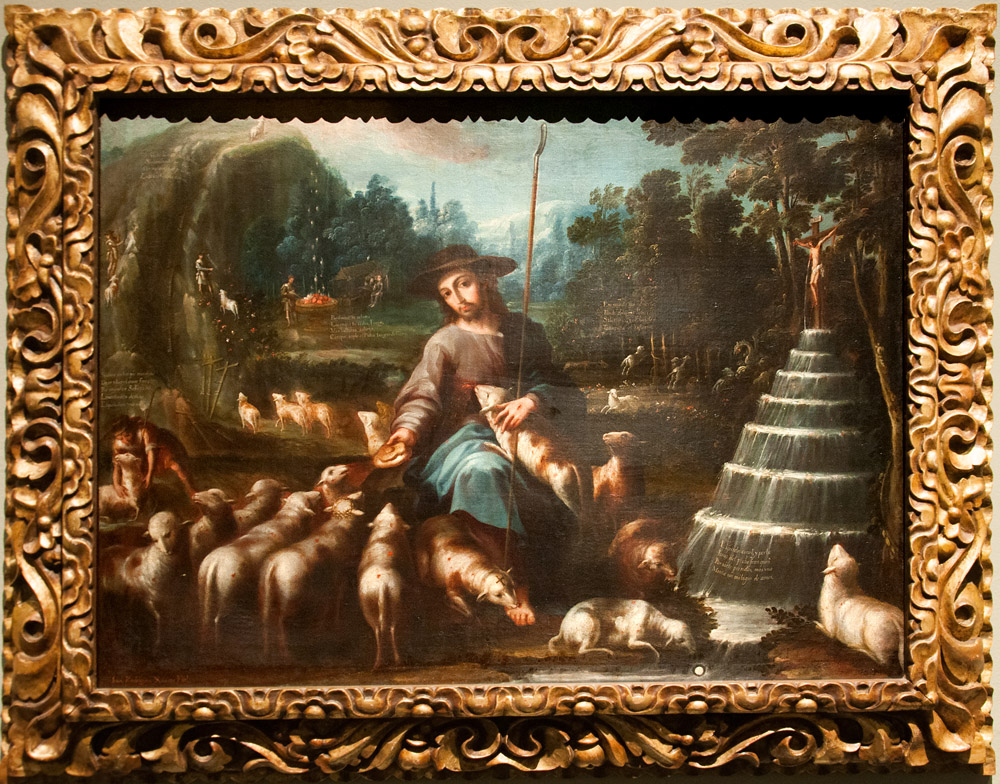Juan Rodríguez Juárez, The Divine Shepherd

Circa 1718
Oil on canvas
Fundación Cultural Daniel Liebsohn, Mexico City
When the Metropolitan Museum displayed this painting, the accompanying label suggested it was originally destined for a convent in Mexico, and many aspects seem specifically relevant to cloistered nuns.
In the background four scenes are arranged chiasmically: the sheep looking into the dark wood on the right are diagonally across from the brightly lit sheep that a shepherd is leading to what the label called "the mountain of glory." The other line of the chiasm leads diagonally from the burning hearts on the left to the watery steps on the right. And where the two lines cross is the heart of Christ, who feeds the sheep in the foreground with his body and blood (the bread he hands them and the blood they take from his wounds).
THE WATER
In the lower right, water from the side of Christ (John 19:34) flows plentifully onto the seven steps to refresh the sheep below. The bottom step is inscribed:
Liquido coral, y perla
Jesus del pecho franqueô
Por siete prendas, mas una
Monta un milagro de amor.(Liquid coral and pearl, pouring from Jesus' breast by seven signs and one, amount to a miracle of love.)
Most likely the seven steps/signs are the seven sacraments of the Catholic Church. And the added "one" would be the Church itself, the pool where the sheep find living water (John 4:10).
THE DARK WOOD AND THE PATH TO GLORY
Behind the seven steps is a dark wood where a monster is about to attack one of the sheep who are contemplating entrance. The inscription warns that those who wander off into the world may end up in the devil's power, a caution relevant to cloistered nuns. All the sheep are in shadow, unlike those diagonally across who are on their way to glory – a glory, the three crosses of Calvary make clear, that is reached by way of being "baptized in his death" (Romans 6:3-4).
A HAND WHEN ONE FALLS
The either/or nature of those two scenes is softened by the one in the lower left, where a shepherd reaches down to a sheep. The inscription tells of Christ's loving care for those whose hearts turn sometimes to the world outside the convent walls:
Si a caso un traspíe mundano
Diere tibio el amor fino
Por impulso Soberano
Levantarâ tu destino
El que te diere una mano.(If by chance a worldly stumble makes a fine love tepid, through an overwhelming impulse he who will give you a hand will raise up your destiny.)
In speaking of a "fine love" made tepid, the poet is assuming that the religious viewers in the usual course of things do have a burning love for Christ; but this love can be tempered if one "stumbles" into worldliness.
BURNING LOVE FOR CHRIST
The idea that the sisters experience burning love for Christ is the subject of the scene in the far background on the left, where a man uses a bellows to further inflame a vessel of burning hearts.
Por divino se aclama
Ese en que tu ardes, Fuego,
Mas hallaras sosiego
Con que sople el Pastor tan grande llama(The fire in which you burn is revealed as divine; you will find rest in that the Shepherd inspires such a grand flame.)
The "rest" is then pictured in the two figures in the simple shelter behind the fire, a dying nun and an angel comforting her.
View this image in full resolution.
Photographed at the Metropolitan Museum of Art by Richard Stracke, shared under Attribution-NonCommercial-ShareAlike license.